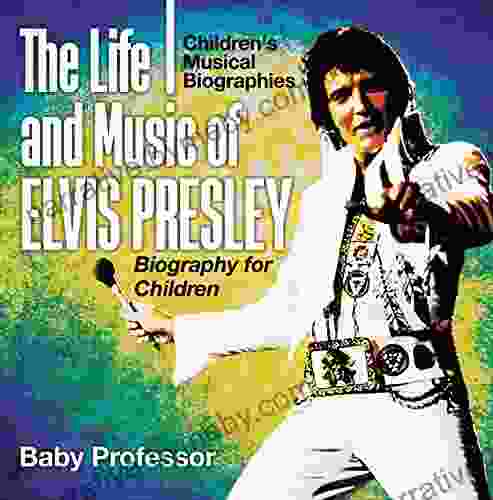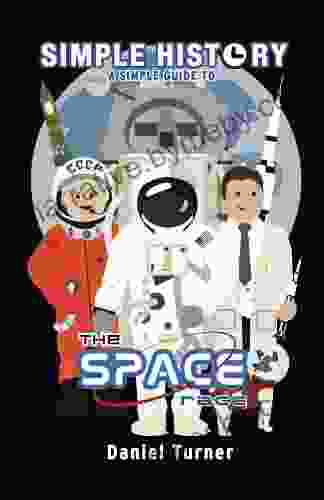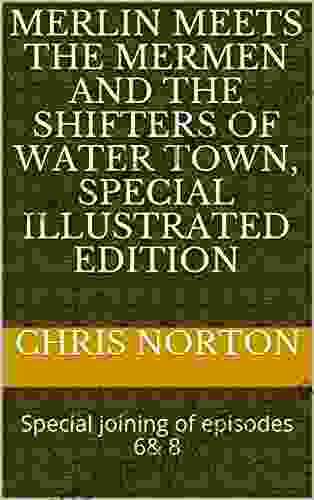The Space Race: A Simple History

The Space Race was a 20th-century competition between the United States and the Soviet Union to achieve firsts in space exploration. The origins of the Space Race can be traced back to the early days of the Cold War, when the two superpowers were engaged in a race to develop nuclear weapons.
4.7 out of 5
| Language | : | English |
| File size | : | 8764 KB |
| Screen Reader | : | Supported |
| Print length | : | 44 pages |
| Lending | : | Enabled |
The Space Race began in earnest in 1955, when the Soviet Union launched Sputnik, the first artificial satellite to orbit the Earth. This event shocked the United States, which had been complacent in its space program. In response, the United States created NASA, the National Aeronautics and Space Administration, and began to invest heavily in space exploration.
The Space Race reached its peak in the 1960s, with both the United States and the Soviet Union sending astronauts to the Moon. In 1961, Soviet cosmonaut Yuri Gagarin became the first human to orbit the Earth. In 1969, American astronaut Neil Armstrong became the first human to walk on the Moon.
The Space Race had a profound impact on both the United States and the Soviet Union. It led to the development of new technologies, including rockets, satellites, and computers. It also inspired a generation of scientists and engineers. The Space Race also had a major impact on the Cold War, as it became a symbol of the competition between the two superpowers.
The Origins of the Space Race
The origins of the Space Race can be traced back to the early days of the Cold War. After World War II, the United States and the Soviet Union emerged as the two superpowers. The two countries were engaged in a race to develop nuclear weapons, and the Space Race was seen as an extension of this competition.
In 1945, the United States dropped atomic bombs on the Japanese cities of Hiroshima and Nagasaki. This event shocked the world and led to the beginning of the nuclear arms race. The Soviet Union responded by developing its own nuclear weapons program, and by 1949, the Soviets had successfully tested their first atomic bomb.
The nuclear arms race led to a new era of tension between the United States and the Soviet Union. Both countries were afraid of the other's nuclear weapons, and they began to build up their military forces. The Space Race was seen as a way to gain an advantage in the nuclear arms race. The country that could develop the most powerful rockets and satellites would be able to launch nuclear weapons anywhere in the world.
The Early Years of the Space Race
The Space Race began in earnest in 1955, when the Soviet Union launched Sputnik, the first artificial satellite to orbit the Earth. This event shocked the United States, which had been complacent in its space program. In response, the United States created NASA, the National Aeronautics and Space Administration, and began to invest heavily in space exploration.
In the early years of the Space Race, the Soviet Union had a clear lead. The Soviets launched the first satellite, the first animal into space, and the first human into space. However, the United States began to catch up in the late 1950s and early 1960s.
In 1958, the United States launched its first satellite, Explorer 1. In 1959, the United States launched its first human into space, Alan Shepard. In 1961, the United States launched its first manned mission to the Moon, Project Mercury.
The Peak of the Space Race
The Space Race reached its peak in the 1960s, with both the United States and the Soviet Union sending astronauts to the Moon. In 1961, Soviet cosmonaut Yuri Gagarin became the first human to orbit the Earth. In 1969, American astronaut Neil Armstrong became the first human to walk on the Moon.
The Apollo 11 mission was a major turning point in the Space Race. It showed that the United States was capable of sending humans to the Moon, and it gave the United States a major propaganda victory over the Soviet Union. The Apollo 11 mission also inspired a generation of scientists and engineers.
The End of the Space Race
The Space Race ended in the early 1970s, after the United States and the Soviet Union signed the Anti-Ballistic Missile Treaty. This treaty banned the development of new anti-ballistic missile systems, and it effectively ended the nuclear arms race. The Space Race also ended because the United States and the Soviet Union realized that they had more to gain from cooperating on space exploration than from competing.
In 1975, the United States and the Soviet Union launched the Apollo-Soyuz mission, the first joint space mission between the two countries. This mission marked the beginning of a new era of cooperation in space exploration.
The Legacy of the Space Race
The Space Race had a profound impact on both the United States and the Soviet Union. It led to the development of new technologies, including rockets, satellites, and computers. It also inspired a generation of scientists and engineers. The Space Race also had a major impact on the Cold War, as it became a symbol of the competition between the two superpowers.
The legacy of the Space Race can be seen today in the International Space Station, which is a joint project between the United States, Russia, and other countries. The International Space Station is a symbol of cooperation and peace, and it is a reminder of the great achievements that can be made when nations work together.
4.7 out of 5
| Language | : | English |
| File size | : | 8764 KB |
| Screen Reader | : | Supported |
| Print length | : | 44 pages |
| Lending | : | Enabled |
Do you want to contribute by writing guest posts on this blog?
Please contact us and send us a resume of previous articles that you have written.
 Book
Book Novel
Novel Page
Page Chapter
Chapter Text
Text Story
Story Genre
Genre Reader
Reader Library
Library Paperback
Paperback E-book
E-book Magazine
Magazine Newspaper
Newspaper Paragraph
Paragraph Sentence
Sentence Bookmark
Bookmark Shelf
Shelf Glossary
Glossary Bibliography
Bibliography Foreword
Foreword Preface
Preface Synopsis
Synopsis Annotation
Annotation Footnote
Footnote Manuscript
Manuscript Scroll
Scroll Codex
Codex Tome
Tome Bestseller
Bestseller Classics
Classics Library card
Library card Narrative
Narrative Biography
Biography Autobiography
Autobiography Memoir
Memoir Reference
Reference Encyclopedia
Encyclopedia Asker Jeukendrup
Asker Jeukendrup Kim Gordon
Kim Gordon Bill Martin
Bill Martin Seth Reichelson
Seth Reichelson Arthur Staple
Arthur Staple Bas Van Der Vossen
Bas Van Der Vossen Sarah Dry
Sarah Dry Barbara Sealock
Barbara Sealock Barry Petersen
Barry Petersen Barney Adams
Barney Adams Mia Leonin
Mia Leonin Ashley Mallett
Ashley Mallett Aubrey Brooks
Aubrey Brooks Joel A Dombrowski
Joel A Dombrowski Zhiqiang Ma
Zhiqiang Ma Audrey Levy
Audrey Levy John Locke
John Locke Becca Anderson
Becca Anderson Sonia Cheadle
Sonia Cheadle Barbara Sheklin Davis
Barbara Sheklin Davis
Light bulbAdvertise smarter! Our strategic ad space ensures maximum exposure. Reserve your spot today!

 Cormac McCarthyDive into the Enchanting World of The King: A Journey Through the Life and...
Cormac McCarthyDive into the Enchanting World of The King: A Journey Through the Life and...
 Howard PowellEmbrace the Joy of Discovery with Fuli: A Captivating Storybook Adventure for...
Howard PowellEmbrace the Joy of Discovery with Fuli: A Captivating Storybook Adventure for...
 Michael SimmonsUnlock Your Crafting Potential: The Best 2024 Step-by-Step Guide for Cricut...
Michael SimmonsUnlock Your Crafting Potential: The Best 2024 Step-by-Step Guide for Cricut... Milan KunderaFollow ·13.4k
Milan KunderaFollow ·13.4k Elmer PowellFollow ·16.7k
Elmer PowellFollow ·16.7k Harvey HughesFollow ·5.9k
Harvey HughesFollow ·5.9k Preston SimmonsFollow ·5.4k
Preston SimmonsFollow ·5.4k Jaylen MitchellFollow ·16.2k
Jaylen MitchellFollow ·16.2k Bill GrantFollow ·6.2k
Bill GrantFollow ·6.2k Galen PowellFollow ·19.3k
Galen PowellFollow ·19.3k Benjamin StoneFollow ·7.4k
Benjamin StoneFollow ·7.4k

 Ian McEwan
Ian McEwanWhy Didn't Anyone Say Anything? Uncovering the Hidden...
By [Author's...

 William Wordsworth
William WordsworthArthurian Legendarians: Faithless One - Part One – A...
In the realm of legendary tales, the...

 Corey Hayes
Corey HayesSSAT ISEE Prep Test: Arithmetic Review Flash Cards Cram...
Are you preparing for the SSAT or ISEE exam?...

 Robert Louis Stevenson
Robert Louis StevensonUnveiling the Essential Guide to Compliance: BCBS 239...
In the ever-evolving...

 Javier Bell
Javier BellJust Peachy: A Tale of Sweetness and Sassiness
Immerse yourself in a...

 Brent Foster
Brent FosterStep-by-Step Instruction Manual to Building a Real Estate...
Are you eager to embark on the...
4.7 out of 5
| Language | : | English |
| File size | : | 8764 KB |
| Screen Reader | : | Supported |
| Print length | : | 44 pages |
| Lending | : | Enabled |






